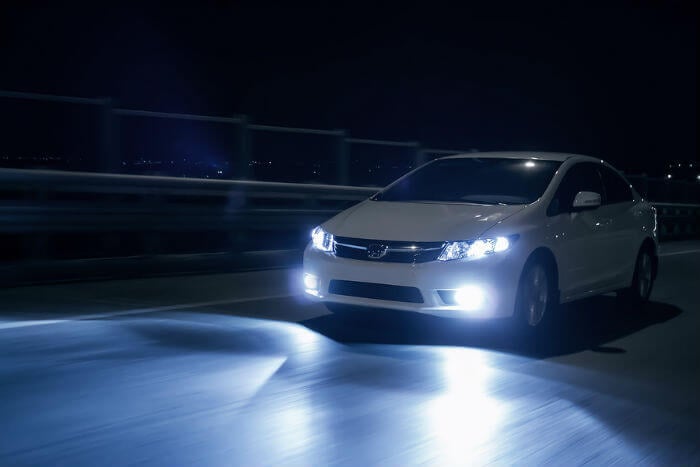Hikari Led Headlight - The Facts
Table of ContentsHikari Led Headlight Things To Know Before You Get ThisThe Ultimate Guide To Hikari Led Headlight5 Easy Facts About Hikari Led Headlight Described


United States lawmakers faced pressure to act, due both to lighting effectiveness and to automobile aerodynamics/fuel cost savings. High-beam peak strength, topped at 140,000 candela per side of the cars and truck in Europe, was limited in the United States to 37,500 candela on each side of the vehicle until 1978, when the limit was raised to 75,000.
As of 2010 halogen sealed beams dominate the sealed-beam market, which has declined steeply because exchangeable-bulb headlamps were permitted in 1983 - hikari led headlight. High-intensity discharge (HID) systems appeared in the early 1990s, first in the BMW 7 Series. 1996's Lincoln Mark VIII was an early American effort at HIDs, and was the only cars and truck with DC HIDs.
Headlamps were round for several years, since that is the native shape of a parabolic reflector. Utilizing principles of reflection, the easy symmetric round reflective surface area jobs light and assists focus the beam. European (top) and US (bottom) headlamp configurations on a Citron DS There was no requirement in Europe for headlamps of standardized size or shape, and lamps might be developed in any shape and size, as long as the lights met the engineering and performance requirements contained in the appropriate European safety requirements.
They were restricted in the United States where round lamps were needed till 1975. Another early headlamp styling principle involved standard round lamps faired into the automobile's bodywork with aerodynamic glass covers, such as those on the 1961 Jaguar E-Type, and on pre-1967 VW Beetles. Headlight style in the U.S.
In 1940, a consortium of state automobile administrators standardized upon a system of two 7 in (178 mm) round sealed beam headlamps on all vehiclesthe just system enabled 17 years. Nevertheless, the Tucker 48 included a specifying "cyclops-eye" function: a third center-mounted headlight linked to the cars and truck's steering system.
A system of four round lights, instead of two, one high/low and one high-beam 5 34 in (146 mm) sealed beam on each side of the vehicle, was introduced on some 1957 Cadillac, Chrysler, DeSoto, and Nash designs in states that permitted the new system. Different low and high beam lamps got rid of the need for compromise in lens style and filament positioning needed in a single unit.
The Best Strategy To Use For Hikari Led Headlight
The four-lamp system allowed more design flexibility and improved low and high beam efficiency. Vehicle stylists such as Virgil Exner performed style research studies with the low beams in their traditional outboard place, and the high beams vertically stacked at the centerline of the automobile, however no such styles reached volume production.
The Nash Ambassador utilized this plan in the 1957 design year. Pontiac used this design beginning in the 1963 design year; American Motors, Ford, Cadillac, and Chrysler followed 2 years later on. Likewise in the 1965 model year, the Buick Riviera had actually concealable stacked headlamps. Numerous Mercedes models sold in America utilized this plan since their click for info home-market replaceable-bulb headlamps were unlawful in the US.
British cars consisting of the Gordon-Keeble, Jensen CV8, Accomplishment Vitesse, and Bentley S3 Continental utilized such an arrangement also (hikari led headlight). In 1968, the newly started Federal Automobile Security Requirement 108 needed all lorries to have either the twin or quad round sealed beam headlamp system, and prohibited any ornamental or protective aspect in front of an operating headlamp.
This made it difficult for vehicles with headlamp setups developed for good aerodynamic efficiency to achieve it in their US-market configurations. When FMVSS 108 was amended in 1974 to permit rectangular sealed-beam headlamps, these were positioned in horizontally arrayed or vertically stacked pairs. By 1979, most of new automobiles in the United States market were equipped with rectangle-shaped lights. [] As formerly with round lights, the United States allowed just 2 standardized sizes of rectangular sealed-beam light: A system of two 200 by 142 mm (7.
6 in) high/low beam units corresponding to the existing 7-inch round format, or a system of 4 165 by 100 mm (6. 5 by 3. 9 in) units, two high/low and 2 high-beam. representing the existing 5 34 in (146 mm) round format. In 1983, approving a 1981 petition from Ford Motor Business, the US headlamp policies were changed to enable replaceable-bulb, nonstandard-shape, architectural headlamps with aerodynamic lenses that might over at this website for the very first time be made from hard-coated polycarbonate.
These composite headlamps were sometimes described as "Euro" headlamps, since aerodynamic headlamps were common in Europe. Though conceptually similar to European headlamps with non-standardized shape and replaceable-bulb building, these headlamps comply with the headlamp design, building and construction, and performance specifications of US Federal Automobile Safety Requirement 108 instead of the internationalized European security requirements utilized outside North America.
Hidden headlamps were presented in 1936, on the Cable 810/812. They were mounted in the front fenders, which were smooth until the lights were cranked outeach with its own small dash-mounted crankby the operator. They aided aerodynamics when the headlamps were not in use, and were among the Cord's signature design functions.
The 6-Second Trick For Hikari Led Headlight
Some concealed headlamp designs, such as those on the Saab Sonett III, utilized a lever-operated mechanical linkage to raise the headlamps into position. During the 1960s and 1970s lots of noteworthy sports automobiles used this feature such as the Chevrolet Corvette (C3), Ferrari Berlinetta Boxer and Lamborghini Countach as they permitted low bonnet lines however raised the lights to the required height, however given that 2004 no modern-day volume-produced vehicle models utilize covert headlamps, due to the fact that click for info they provide troubles in abiding by pedestrian-protection arrangements included to global auto safety regulations relating to protuberances on car bodies to lessen injury to pedestrians struck by cars and trucks.